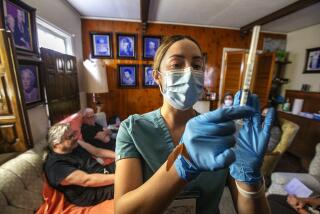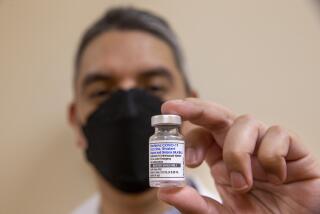State Gets More Vaccine
- Share via
The first new batch of flu vaccine arrived in California on Friday, weeks ahead of schedule and amid early signs that this season’s flu strain could prove more manageable than originally believed.
The federal government provided the state with 271,740 doses of the vaccine.
Although it was only a fraction of the amount needed to handle the millions of people at high risk of complications from the illness, the delivery was one of two pieces of good news for medical officials.
The other came from new data, still preliminary, suggesting that people who get flu shots should be well protected from this year’s strain and that those who got the flu last year may be better able to ward it off this season.
Officials base the assumptions on early cases of the flu in the Northeastern states, which suggest that the strain, known as A Fujian, is affected by this year’s vaccine. The same strain hit last season, so people who got sick then have a possible measure of protection.
“If you were exposed to A Fujian last year and it happens to be the dominant strain this year, you may have some immunity,” said Christine Pearson, a spokeswoman for the U.S. Centers for Disease Control and Prevention.
Flu vaccines in the past have not always been effective because they didn’t combat the flu strain spreading in a particular year.
There have been too few cases of the flu in California yet to determine what to expect from the flu season, which can peak any time between December and March. Pearson warned that it was still too early to know with certainty that A Fujian would be the most common flu strain in the coming months.
The nation’s supply was cut in half after British regulators suspended the license of a pharmaceutical plant in Liverpool because of manufacturing problems and possible contamination. The plant, which makes the flu vaccine for Chiron Corp. of Emeryville, Calif., was expected to produce 46 million doses for the U.S. market.
The federal government intends to distribute the remaining 22.4 million doses of vaccine it secured from the other major vaccine manufacturer, French-based Aventis Pasteur, directly to public health officials in hopes they will get into the hands of those who need the shots the most.
Of the 271,740 doses distributed to California, Los Angeles County will receive 60,060. Orange County will get 24,760, Riverside County will get 11,950, San Bernardino County will get 13,090 and Ventura County will get 6,290.
The distribution was based on the high-risk population -- including senior citizens, young children, pregnant women and people with compromised immune systems -- in each county and on an analysis of past need for the flu vaccine. Los Angeles County, for example, estimates that 2.8 million people fall into the high-risk category.
Los Angeles County plans to ship a portion of its allotment to senior centers and open several clinics to offer shots to high-risk people. Officials were meeting Friday to come up with a plan to avoid a rush on the clinics similar to what occurred over the last few weeks at drugstores and supermarkets.
“We are anticipating logistical issues so that people don’t come three days in advance and camp out only to wait another eight hours to miss the shot,” said Laurene Mascola, chief of the acute communicable disease control program for the L.A. County Department of Health Services.
To avert a barrage of flu shot seekers, ideas being considered include having people register a day before clinics open on a first-come, first-served basis or using a lottery for those who sign up for shots.
It remains unclear when or how many more of the 22.4 million doses available nationwide will come to California.
Mascola said there is still plenty of time for people to be vaccinated before the flu season arrives.
Officials do not know how many high-risk patients have already received vaccinations, but more are expected to seek the shot this year because of media coverage of the shortage. Even if more vaccine arrives in the coming weeks, it won’t be enough to cover all high-risk patients.
Public health departments across Southern California usually provide the flu vaccine only to people who cannot afford to pay for the shots. Most people get the vaccine from hospitals, retailers and doctors’ offices. Although health agencies have received little or no vaccine this year, some private health providers got shipments and have been providing the shots to patients.
But officials are urging that people not in the high-risk category forgo the vaccine this year.
Health departments suggested that people consider using anti-viral medicines or the nasal inhalant FluMist if they can’t get vaccinated. The most effective preventive step, they say, is good hygiene: People should wash their hands frequently, refrain from touching their noses and mouths and stay home if they are ill.







